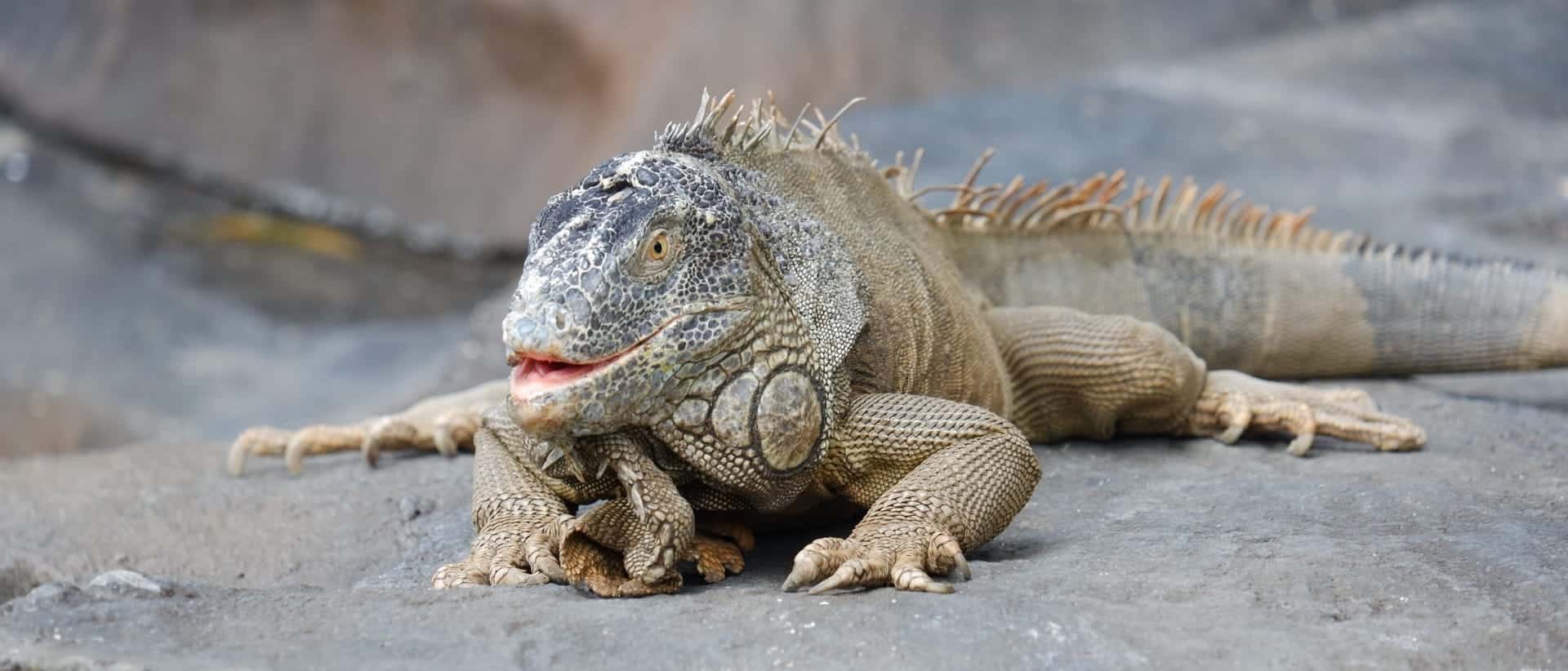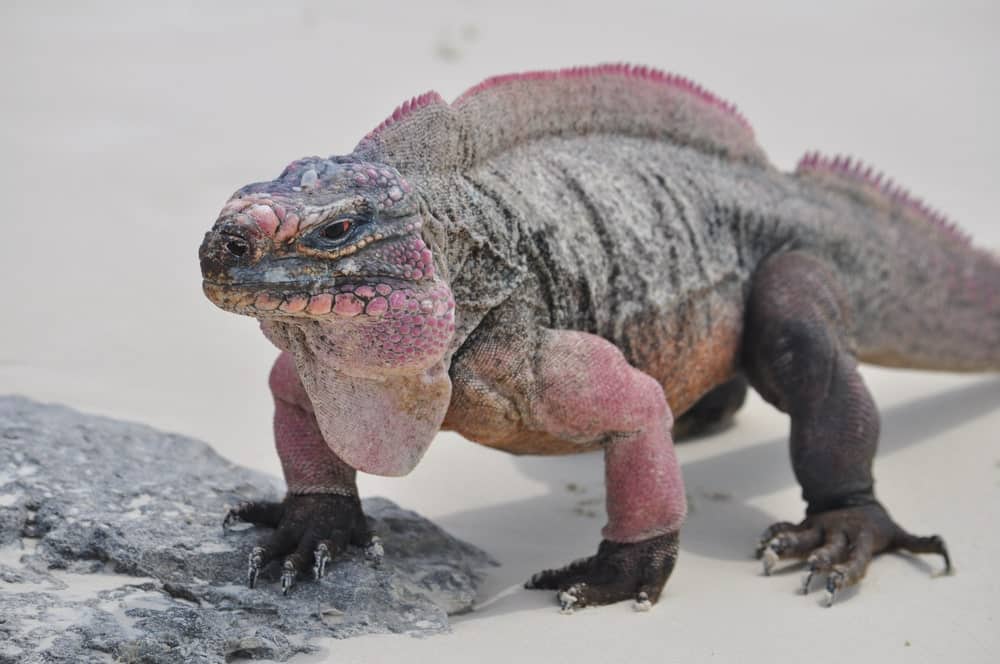There are many different iguana colors. The main reason for varied colors is the different types of iguanas and where they live. There are currently over 35 recognized iguana species, all with different skin colors.
Iguanas change color depending on their body temperature or their mood. If an iguana is turning brown, it could be due to a parasite infection or lack of vitamin A. In addition to color change, if an iguana is in cold temperatures, they may develop dark wavy lines all over their bodies.
Iguanas cannot change color as quickly as chameleons, but they can change color depending on the season, their mood, and the environment. Temperature change is responsible for most of the iguana’s changes in color. Pink, yellow, orange, red, blue, and green iguanas can be found abundantly in Florida. During mating season, many iguanas turn orange to attract their mates.
Iguanas are native to Central America, South America, and the Caribbean, as they require more heat. Most iguanas and other lizards came to Florida through the pet trade, where they soon became popular. The dominant males will carve out their own territories and prevent other males from entering their space. They will, however, allow females to spend time or pass through their environment.
Green Iguana
These common green iguanas are large lizards. Though not native to Florida, they can be found throughout the state. Hatchlings and juveniles have a bright green color. Adult green iguanas have shades ranging from brilliant green to dark brown to almost black.
As part of the same family, you can also find albino iguanas with yellowish or pale scales.
Mature male iguanas change to an orange color during the breeding season. Their jowls become enlarged, and their neck fan bulges to attract mates. South Florida has the largest population of green iguanas near bodies of water. A female green iguana typically lays 70 eggs each year.
The fecal matter of iguanas can contain salmonella, which is a huge health risk for pets and humans, especially when the feces is located in or near swimming pools.
Mexican Spinytail Iguana
Mexican Spiny Tail Iguanas get their name from the rigid scales seen on their tails. They are usually gray or brown with a yellow abdominal surface.
They prefer a rocky habitat that has crevices to provide them shelter, and they are naturally great climbers. Mexican Spinytail Iguanas are primarily herbivores; however, they are opportunistic feeders and will eat arthropods, eggs, and small animals.
Mexican Spinytails are usually more aggressive than the common green iguana and will scratch or bite if cornered by humans.
Black Spiny Tailed Iguana
It is difficult to distinguish these from the Mexican Spiny Tails. Still, Black Spiny Tail Iguanas have scales that separate the short crest along their back and tail, two complete rows of intercalary scales in between the whorls of distended scales on their tail, and dark back crossbands. The Black Spiny Tailed Iguana is native to Costa Rica.
Throughout South Florida, Black Spiny Tailed Iguanas dig burrows under structures, such as sea walls, sheds, and houses. They are agile and alert and usually dash to their boroughs at any sign of danger.
Curly Tailed Lizard
The Curly Tailed Lizard is the second most commonly found lizard non-native to South Florida. Its name comes from its distinct curly tail. They have a mixed color of dark brown and dark gray, and their body can grow upwards of 11 inches long. Like other reptiles, they are omnivores, and they eat plants and smaller vertebrates.
Fiji Banded Iguana
The Fiji Banded Iguana resides primarily on the Lau Islands in Fiji. Their bright bodies have thick pale bluish-white or yellow stripes or bands criss crossing their vibrant green bodies.
The gorgeous Fiji Banded Iguanas will change their color slightly to blend in with their environment and hide from predators.
Unlike other iguanas, the Fiji Banded Iguana does not have pronounced back spikes. Therefore, they have a more approachable and softer appearance. They are smaller compared to Green Iguanas, reaching roughly 24 inches with a weight of less than one pound when fully grown.
They spend their day basking in the sun and their evenings on the treetops to sleep. Unfortunately, Fiji Banded Iguanas are now a threatened species.
Fiji Crested Iguana
The Fiji Crested Iguana is a critically endangered species of the Northwestern Islands of Fiji. This iguana is a large, stocky lizard that is distinguishable from the other species of Fiji Banded Iguana due to the three narrow white or cream bands on the males.
They can grow to 30 inches long and weigh under a pound. They have a spiny crest along their back that is just over half an inch long. When they hatch, the iguana’s skin has a dark green color, but several hours later, they become bright emerald green, and the narrow white bands begin to appear along their body. They have a reddish-orange or pinkish-gold eye color.
Grand Cayman Blue Iguana
These vibrant-colored iguanas are massive in size, and both females and males can reach lengths of over five feet and weigh up to 30 pounds.
Grand Cayman Blue Iguanas start their life with a more dull color and slowly become more vibrant as they get older. These iguanas display a slight sexual dimorphism. Female iguanas are often greenish blue, and males are typically turquoise blue to gray-blue. Like many iguanas, Grand Cayman Blue Iguanas can slightly change their color to establish dominance over other iguanas.
Cuban Rock Iguana
This large lizard is native to the Southern Coast of Cuba and is dark brown or green in color with dark brown markings on its body. Although they are the second largest species that inhabit the West Indies, they are also considered one of the most endangered species.
Due to the rise of natural predators and the destruction of the Cuban Rock Iguanas’ natural habitat, they are in danger of extinction.
Rhinoceros Iguanas
Rhinoceros Iguanas are aptly named after rhinos due to their bony horn-like projection from their snout. Though it may look intimidating, most rhinoceros iguanas do not use their horns to fight. The iguana uses the horn to protect itself from rocks or other hard surfaces.
Their natural habitat is between rocks of the Caribbean islands, though they can climb trees. Rhinoceros iguanas are large, muscular, and strong and can grow between four and five feet and get as large as 20 pounds. This species of iguana is also endangered.

Galapagos Iguanas
The Galapagos have a few iguana species, but Galapagos Island Iguanas are classified as marine iguanas or land-based iguanas. Galapagos Land Iguanas are not vibrantly colored and do not have any remarkable features. The bottom of their body is a burnt orange color while the top is typically brownish red coloration.
They can grow to about three feet long, and they do not prefer to climb very often. They enjoy basking in the sun or laying on a volcanic rock to help them regulate their temperature.
This species does not forage for food in the ocean. They prefer to hang out in the dry lowlands of several different islands. Their diet consists mostly of plants, but they will occasionally eat insects for a high-protein snack. Some of these iguanas will eat the decayed flesh of dead animals.
Galapagos Island Iguanas have a special symbiotic relationship with certain birds. They will allow the birds to pick ticks and parasites off of their bodies to get much-needed relief.
Desert Iguana
Desert Iguanas can be found in the Mojave and Sonoran Deserts in Northwestern Mexico and the Southwestern United States. These iguanas use physiological thermoregulation to achieve their preferred body temperature of roughly 98.6 degrees Fahrenheit.
They have a pale gray-tan to light cream color and a light brown reticulated pattern along their sides and back. Along its back, you will find a row of enlarged-keeled dorsal scales that grow in size as you move downwards.
They are covered with black and rusty brown accents. Both males and females turn a pinkish color during the breeding season. Desert Iguanas also lack the defined spikes that other iguanas have.
Most iguanas are known for blending into the dense, tropical foliage for climbing trees, but the Desert Iguana does not. They do, however, climb bushes and rocks. Desert Iguanas enjoy the dry heat and barren lands of North America.
Red Iguana
Red Iguanas are a variant, or “morph” of green iguanas, despite what many reptile enthusiasts had originally thought. Red Iguanas can range in color from a deep, crimson red to neon orange. Many Red Iguanas have patches or splotches of green speckled throughout their bodies.
Reptile breeders have carefully been breeding Green Iguanas to display the darker shade of red colors. The darker red the iguana is, the more “rare” and expensive they are. Red Iguanas can grow to seven feet before they are even fully grown. Males are typically larger than females.
West Indian Rock Iguana
There are about 10 different species of West Indian Rock Iguanas, as well as several subspecies. They originate from the West Indies, and many are classified as critically endangered. Therefore, they are a rarity within the pet trade. West Indian Rock Iguanas can vary in size from the smallest being roughly two feet, with the larger varieties growing well over five feet long.
Their physical appearance can vary because there are so many subspecies, but they generally have well-defined features, such as scaly skin, wide jowls, and large spikes, and are often much beefier than other iguanas. Their colors typically include black, gray, and brown.
Angel Island Chuckwalla
The male Angel Island Chuckwalla typically has dark or even black front limbs and heads, and their bodies are a shade of brown, orange, gray, or black. Juvenile Chuckwallas have yellow or gray bands across their body, and the female Chuckwalla typically keep these bands as they get older. The Angel Island Chuckwalla has a pale yellow tail with dark bands that are often lighter shades than the rest of its body.
Chuckwallas have developed dark and protective skin that is usually scaly and thick to protect them from the hot sun. Their stocky bodies usually grow to lengths of 18 inches.
The Chuckwalla does not live surrounded by trees and vegetation of tropical regions but rather prefers the arid deserts of North America.
Northeastern Spiny Tail Iguana
Native to Guatemala and Mexico, Northeastern Spiny Tail Iguanas have a distinct keeled scale along their long tails. They tend to be excellent climbers and prefer to live in rocky habitats that have many crevices to hide, nearby trees to climb on, and rocks to bask in the sun. Northeastern Spiny Tail Iguanas are mainly herbivores and enjoy eating flowers, leaves, fruit, and stems. However, they will eat eggs, arthropods, and smaller animals if they are given the opportunity.
Northeastern Spiny Tail Iguanas can grow to be lengths of three feet long or longer. These iguanas tend to be defensive, flighty, and nervous but will not think twice about biting a person or animal that may be threatening to attack it.
Iguana Control of South Florida
Many people choose to have iguanas as pets, but Florida residents struggle with nuisance iguanas on their property. If this is the case for you, contact Iguana Control today for a free consultation.


